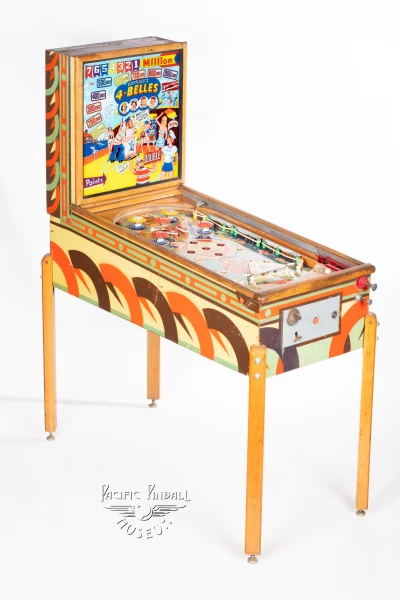4 Belles
4 Belles Preview Image

Machine Details
Manufacturer

Gottlieb
Year
1954
Technology Era
Electro-Mechanical (EM)
Machine Description
4 Belles (1954)
D. Gottlieb & Company
Released in the golden age of pinball, the 4 Belles emerged from Gottlieb's Chicago factory in 1954 as a testament to both artistic elegance and mechanical innovation. The machine's theme celebrated feminine beauty, featuring four stylized women's portraits that captured the glamorous aesthetic of the 1950s. Designer Art Stenholm created the playfield layout, while Roy Parker's distinctive artwork embodied the era's illustration style.
In post-war America, when pinball was experiencing a remarkable resurgence, the 4 Belles represented a shift toward more sophisticated and family-friendly themes. This was particularly important as the industry worked to shed its gambling associations and establish pinball as legitimate entertainment. The machine's clean design and wholesome imagery helped position it as acceptable entertainment in an era of strict social codes.
Technically, the 4 Belles featured innovations that would influence pinball design for years to come. Its four-player functionality was still relatively new for the time, and its scoring system introduced novel mechanical features that made gameplay more engaging. The machine utilized Gottlieb's reliable flipper design, which had become an industry standard since their introduction in 1947.
The 4 Belles proved popular in locations ranging from drugstore soda fountains to bowling alleys, where its elegant appearance and reliable mechanics made it a consistent earner. The machine's success helped cement Gottlieb's reputation as the "Cadillac of pinball," known for producing high-quality games with superior craftsmanship.
Today, the 4 Belles stands as a cherished example of 1950s pinball artistry and engineering. Surviving examples are highly sought after by collectors, not only for their historical significance but also for their representation of mid-century American popular culture. The machine's artwork and design continue to influence modern pinball aesthetics, serving as a reminder of an era when mechanical amusement devices were at the height of their cultural influence.